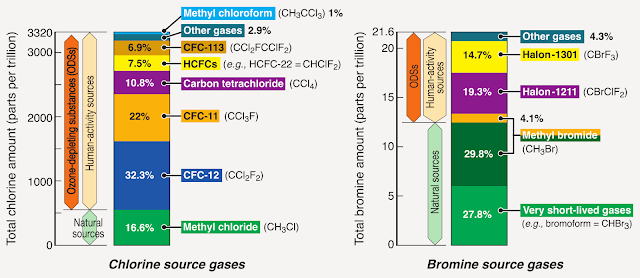They say that you should save the best news for last.
Today's specialist appointment was with Dr Solomon and Nurse Fahey-Hegglin. It was breath of fresh air. Who would be a climate or biodiversity specialist when you could be an ozone specialist!?
According to my GP, Dr Steffen, my skin's stratospheric ozone layer (SOL) plays a vital role in protecting my terrestrial and marine organisms from the Sun's most harmful ultraviolet radiation, especially UV-B. Therefore, when human scientists discovered over 30 years ago that ozone was depleting globally and a 'hole' was forming over my Antartica in the Austral Spring, there was widespread consternation. But meanwhile, some industrious humans—such as Mario J. Molina and F. Sherwood Rowland—were busy trying to uncover what was actually causing the depletion. Soon enough, they discovered that the proliferation of a small number of human manufactured chemicals—now called ozone-depleting substances (ODSs)—were the culprits.
 |
My Ozone Depleting Substances (Source: Ozone Assessment 2010) |
Today's appointment centred on assessing my current ozone levels globally with particular emphasis on the extent of my Antarctic 'Ozone Hole'.
Dr Solomon used a variety of instruments as well as local and remote techniques to gauge my current ozone condition. Using a contemporary Dobson spectrophotometer and special balloons, she was able to collect local data at my South Pole station and picked up remote trends using a Solar Backscatter Ultra-Violet satellite. Very impressive. While Dr Solomon collected her final pieces of data, Nurse Fahey-Hegglin explained concepts relating to how (and why) ozone is distributed unevenly across my surface, its 90% predominance in my stratosphere compared with my troposphere and more information about ODSs generally. The Nurse referred to my ODSs as 'manufactured halogen source gasses' such as chlorofluorocarbons (CFCs) and halons (e.g. Halon-1211) in order to differentiate them from 'natural halogen source gasses' such as methyl chloride (CH3Cl).
 |
Annual distribution of total ozone (Source: Ozone Assessment 2010) |
Dr Solomon and Nurse Fahey-Hegglin's full results:
 |
Medical Report #7: Stratospheric Ozone Depletion |
Dr Solomon convinced me through pure data that my overall ozone levels had stabilised and my ozone hole was slowly 'closing', despite variability to do with seasonal fluctuations in temperature, transport dynamics and "volcanic aerosol chemistry". By using a comprehensive range of data sets and comparing 'September' trends from 1980 - 2000 with 2000 - 2014, Dr Solomon showed a clear decreasing trend in my 'Ozone Hole' extent:
 |
| Ozone Hole Trends (Source: Science) |
What struck me especially about my ozone levels was its ability to fluctuate year on year depending on different variables. For example, the large 'holes' in 2011 and 2015 have been attributed to my Chilean eruptions of Puyehue-Cordón Caulle and Calbuco respectively. The size of the 2015 hole was estimated to have been a whopping 4.4 million km2 larger because of the eruption of Calbuco!
Another fascinating fact I discovered was the relative success of the human-created Montreal Protocol that prescribes limits on ODSs. Due to Kyoto Protocol's abject failure, I thought that 'top-down' human agreements were always under-achievers. It was timely to learn that humans could actually come together and solve a big problem. At current trends, the Montreal Protocol will likely have reduced ODSs to pre-1980 levels by as early as 2050.
Yours for awhile,
Bluey
Web Development Company
ReplyDeleteGreat job
ReplyDeleteEnvironmental Change